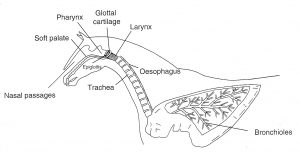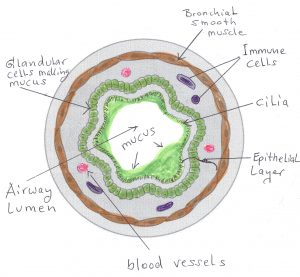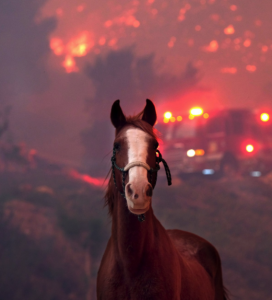Smoke inhalation in horses – reduce the damage
Once again, like every year, the United States West Coast is in fire season. While the percentage of horses directly exposed to fire luckily remains comparatively small due to precautionary evacuations, thousands of horses are exposed to smoke from fire. Nothing can prevent the ashes and smoke to be carried many miles. Each year horse owners worry about their horses suffering damaged from inhaling smoke. There are measures a horse owner can take, besides practicing best effort to protect a horse from smoke exposure in the first place. Reducing exercise is the first step. Give your horse time to recover from any smoke exposure. Airway irritation resulting from wildfire smoke might take a full month to subside, longer if there were clinical symptoms of illness. You might want to allow yourself and your horse at least two weeks after smoke exposure before returning to the routine exercise program. Furthermore, limit exposure to dust by taking your horse out of the stall when replacing the shavings. Spraying them lightly using a water hose helps setting the dust faster. Feeding dust-free hay or soak hay before you feed. Dampen the feed in the bucket as well. This reduces the dust particles your horse overall is exposed to. Do not use a leaf blower to clean the dust away in your barn alley. I have seen this done in top-notch performance barns and it makes me cringe. By the way, whether fires or not, these are generally useful practices.
But what else? What if your horse has inhaled smoke? How do you know your horse suffers from smoke exposure? What preventative measures can you take even if your horse seems normal?
How do you know your horse suffers from smoke exposure?
Absence of cough is not a sure sign! Contrary to humans, horses are much less likely to cough, even when they have quite severe respiratory problems. Compared to humans, horses do not have as many cough-reflex triggering sensors in their lungs. This makes sense if you recall that horses are prey animals. A prey animal’s survival depended on hiding or fleeing. It was essential not to be easily seen or heard by predators. Frequent coughing could have meant death by predatorial attack. Studies have shown that in horses coughing has a 84 percent specificity but only a 36 percent sensitivity for detection of a respiratory disease. This means that if your horse is coughing, there is a high chance for respiratory problems. But if your horse is not coughing, the chances that your horse is healthy are small. How can you tell? The bad news is that sometimes you can’t.
Below are general evaluation guidelines written by Drs. Gary Magdesian and Joie Watson, School of Veterinary Medicine UC Davis:
“Horses exposed to fire smoke can suffer respiratory injury of varying degrees, ranging from mild irritation to severe smoke inhalation-induced airway or lung damage. Knowing what is normal versus concerning can help to know whether your horse should be evaluated by a veterinarian.
Respiratory rate at rest should be 12-24 breaths/minute.
Horses should be examined by a veterinarian if any of the following are noted:
- Respiratory rate is consistently greater than 30 breaths/minute at rest
- Nostrils have obvious flaring
- There is obvious increased effort of breathing when watching the horse’s abdomen and rib cage
- There is repetitive or deep coughing, OR
- Abnormal nasal discharge.
Horses should also be monitored for skin and tissue injury, especially for the first few days after exposure.”
If you do notice any of the signs described above, you should contact your veterinarian. Your horse might need specific treatments such as intravenous fluids, drugs to widen the airways or measures to hydrate of the airway passages by medical intervention. Laboratory tests might be needed to check for bacterial infections.
Yet, even if your horse does show a normal respiratory rate and displays none of the signs described above, long term effects from smoke exposure might occur. These could be allergies, a reduced immune system inviting infections or chronic obstructive airway disease (COPD). Further below you will find a natural four- week program which is designed to cleanse your horse’s lungs and detox the body. Many of my show riders use this program routinely once a year in the off-season as a health-enhancing measure for their horses, and actually for themselves as well. For your own health, please view link to my newspaper publication on human lung cleansing at the end of this article. It was published in light of the COVID crisis.
What you should know about your horse’s lungs
 The better you understand the lungs’ defense mechanism, the more effective you can use a lung cleansing program for your horse, because you know why you are using these measures. Let’s take a quick course in anatomy and physiology. If we followed an air particle from the atmosphere down through the airways, we would pass through the following structures: Nostrils, nasal passages, pharynx, larynx, trachea, bronchi, bronchioles, alveolar ducts and alveoli. Imagine a tree, with the trachea representing the trunk and the airways following from it are the branches, which get smaller and smaller every time they divide. In the horse, these divisions can go on for 38-43 times. The upper “conducting” airways lead the air further down. The lower airways are called “respiratory airways” where gas exchange takes place between the lungs and the blood stream.
The better you understand the lungs’ defense mechanism, the more effective you can use a lung cleansing program for your horse, because you know why you are using these measures. Let’s take a quick course in anatomy and physiology. If we followed an air particle from the atmosphere down through the airways, we would pass through the following structures: Nostrils, nasal passages, pharynx, larynx, trachea, bronchi, bronchioles, alveolar ducts and alveoli. Imagine a tree, with the trachea representing the trunk and the airways following from it are the branches, which get smaller and smaller every time they divide. In the horse, these divisions can go on for 38-43 times. The upper “conducting” airways lead the air further down. The lower airways are called “respiratory airways” where gas exchange takes place between the lungs and the blood stream.
Did you know that a horse’s gas exchange surface area is almost equivalent to ten (10) doubles tennis courts?
The lung cleansing program targets different areas in the airways and you should know what these are. In a simplified cross-section of a lower respiratory bronchi you can see several layers of tissue or material. Each of these layers plays a different role in the lung’s defense mechanism. While the upper bronchial system and trachea are held in form by a layer of cartilage, this cartilage is missing in the lower portion of the bronchial system. Here, from the outside in, a thin layer of connective tissue is followed by a ring of smooth muscle. This layer of smooth muscle controls the diameter of the airways. The airways will be the widest when the smooth muscle around them is relaxed. The “smooth muscle” system in the mammal’s body is controlled by the autonomous nervous system, which regulates the body via reflex mechanism and unconscious processes. This system also regulates your heart beat or your gut movements. While you and your horse can move the extremities voluntarily, neither one of you can willingly influence the contraction of the smooth muscle surrounding the respiratory airways. In the event of an “attack” to the lungs by smoke inhalation, dust exposure or infections, the smooth muscle layer can contract in various degrees. It can shut the lower airways completely off in the effort to prevent harmful particles to reach the lowest airways and get into the body by diffusion. Yet, at the same time the amount of oxygen coming through is reduced as well. Contraction of the smooth muscle layer is present in an asthma attack for example.
 The next layer towards the inside is called “epithelium”. This layer holds blood vessels and cells which perform different functions, including immune defense and cells for inflammatory response. During inflammation this layer will swell up and thicken, narrowing the diameter of the airway as well. In the upper parts of the respiratory tract the epithelium is “ciliated”, which means it has many tiny folds on its surface, “cilia”, which move together like hairy waves to transport foreign particles such as smoke, dust and dead immune cells up and out towards the larynx. The lungs are a one-way street system. Foreign matter and waste products have to be transported against gravity up the stream. There is only one way out and that is up. You can therefore help your horse eliminate these particles by feeding from a rubber tub on the floor instead of a hanging hay net. This way at least portions of the trachea angle downwards while your horse’s head is lowered. The last layer of material is mucus produced by the glandular cells in the epithelial layer. The mucus coats the particles to disable them from harming the lungs so that the cilia can produce those mucus plugs outwards. When the lungs are irritated the mucus production will be increased. This can further reduce the diameter of the airways. Mucus is a water-based gel mostly consisting of proteins, immunoglobulins and lipids. In the absence of water, or if the mucus sits too long in one spot, it dries out and becomes in itself a foreign body and irritant to the lungs. It is therefore absolutely essential to effectively hydrate the respiratory system. If your horse is dehydrated, which is often a natural occurrence after a stressful event, the natural lung-cleansing process might be compromised. More about this further below. In summary, the different mechanisms which can shut off the air supply to your horse’s body are, now from the inside out:
The next layer towards the inside is called “epithelium”. This layer holds blood vessels and cells which perform different functions, including immune defense and cells for inflammatory response. During inflammation this layer will swell up and thicken, narrowing the diameter of the airway as well. In the upper parts of the respiratory tract the epithelium is “ciliated”, which means it has many tiny folds on its surface, “cilia”, which move together like hairy waves to transport foreign particles such as smoke, dust and dead immune cells up and out towards the larynx. The lungs are a one-way street system. Foreign matter and waste products have to be transported against gravity up the stream. There is only one way out and that is up. You can therefore help your horse eliminate these particles by feeding from a rubber tub on the floor instead of a hanging hay net. This way at least portions of the trachea angle downwards while your horse’s head is lowered. The last layer of material is mucus produced by the glandular cells in the epithelial layer. The mucus coats the particles to disable them from harming the lungs so that the cilia can produce those mucus plugs outwards. When the lungs are irritated the mucus production will be increased. This can further reduce the diameter of the airways. Mucus is a water-based gel mostly consisting of proteins, immunoglobulins and lipids. In the absence of water, or if the mucus sits too long in one spot, it dries out and becomes in itself a foreign body and irritant to the lungs. It is therefore absolutely essential to effectively hydrate the respiratory system. If your horse is dehydrated, which is often a natural occurrence after a stressful event, the natural lung-cleansing process might be compromised. More about this further below. In summary, the different mechanisms which can shut off the air supply to your horse’s body are, now from the inside out:
- Excessive or dried up mucus in the airway lumen
- Inflammation and thickening of the bronchial epithelial layer
- Contraction of the smooth muscle around the bronchi
With all this going on, your horse might still not be coughing.
Based on the information above, let’s discuss which measures will produce relief to your horse:
General Hydration
This is one of the simplest yet most powerful measures. Whether your horse has an automatic water feeder or not, I recommend placing a large water bucket into the pen or stall. This will also enable you to measure how much water your horse drinks every day. Most likely your horse will prefer the bucket to any automatic water feeder because it is easier to drink from the bucket. Place the bucket close to where your horse eats. Horses drink most of their water within two hours of eating hay. Placing the bucket close to the feeder naturally increases water consumption. If your horse does not like the new taste of the water in the barn placed in during evacuation, you can filter the water with a garden hose filter. These filters come in very handy for shows or travel as well. The filter not only neutralizes the taste but also eliminates chemicals sometimes contained in ground- or city water.
Your horse will drink more if you add unrefined sea salt to the horse’s feed bucket. Do not add salt to the drinking water! The amount of salt you add depends on how much feed is in the bucket. You can add a tablespoon of salt per every two pound of concentrate but do not add more than two tablespoons. Adult horses weighing a thousand pound require two to four tablespoons (30-60 gram) of plain salt daily. On hot days or after heavy exercise, due to the loss in sweat, this requirement can increase to eight tablespoons of plain white salt, sodium chloride. In addition hang a small bucket with lose sea salt into your horse’s stall for free choice. Salt licks usually do not work. Few horses like to use them to the extend the salt is needed.
Specific lung hydration
If you have a nebulizer for your horse, this is the time to use it daily. The humidity provided by the device helps moisturizing the mucus in the airways so it can be transported out by the cilia as described above. Any other approach to hydrate your horse’s lungs directly becomes a Veterinary intervention and requires intravenous infusion. A specialty lung clinic for horses in Germany, where I used to work, took this to the extreme with at the time great results, although the intervention increases the blood pressure and carries a risk. Therefore these horses had to be closely monitored for their heart rate, respiratory rate and other vital signs. With this method we treated many horses with chronic airway diseases. It was a hyper-infusion of isotonic saline solution. Fluid transfer from the blood into the alveolar system works by pressure depending osmosis. By increasing the body’s blood volume, the pressure in the pulmonary capillaries increased and water would be osmotically “pushed” from the capillaries into the alveoli and bronchi. Success was measured by subsequent bronchoscopy. The intent was to separate and liquify the old crusty mucus from the pulmonal epithelia to then transport it out. As you can see, this is a very specific and tricky process which we should leave up to the experts.
Liquify mucus with a supplement
The same lung clinic routinely used a substance called “Fluimucil®”. While in Germany and in many other countries the access to the ingredient requires a prescription, in the United States it is sold as a supplement. N-Acetyl-Cysteine (NAC), an amino acid, has amazing properties for lung health as well as for liver detox, both very helpful in the event of smoke exposure or any other lung irritation. NAC liquifies the mucus in the lungs and makes it watery, which enables the lungs to easily transport it out. For use in horses I recommend NAC powder which can be purchased in bulk online. For an adult horse with a body weight of one thousand pounds, I recommend to mix one level teaspoon (5 gram) of NAC with moistened food twice a day, daily and eight hours apart for the duration of 30 days.
Reduce bronchial constriction
Relaxing the smooth muscle around the Equine bronchi requires a medication and therefore the assistance of your Veterinarian. For the most effectively way to clean your horse’s lungs, a combination of hydration, NAC and bronchial dilation is required. This combination approach will open the airways by relaxing the muscles around them and liquify the mucus to increase so called “mucociliary clearance”. Clenbuterol, under the name “Ventipulmin(R)” is FDA-approved medication for horses with reversible bronchospasm. Clenbuterol is available as a syrup and relatively palatable. It is not a steroid, but has anabolic effects. It promotes muscle building, therefore your horse cannot compete on it. Please check for your discipline what the withdrawal times are.
Reduce epithelial inflammation
Whether your horse needs support to reduce inflammation in the bronchial epithelial layer is a decision your Veterinarian should make. Unfortunately, commonly used anti-inflammatory drugs such as Banamine and Phenybutazone, aka “Bute” do not work well for this purpose. The drugs of choice are Corticosteroids, but these can also inhibit your horse’s immune response.
Take away message:
If your horse has been exposed to smoke, besides management measures, determine the severity of the damage and involve your Veterinarian if needed. For lung cleansing, hydrate your horse and provide salt as described. Use a 30 day course of NAC, 5 gram twice daily, mixed with feed, and combined with Clenbuterol twice daily, amount according to your Veterinarians instructions, to cleanse your horses lungs and detox the body.
Be safe and take care of yourself!
Disclaimer:
The information herein is for educational purposes only. It is not intended to represent or replace Veterinary diagnostics or -treatment. If you are in doubt or your horse needs Veterinary treatment, please contact your Veterinarian’s office.
About the author:
Dr. Gabriele Gross, PhD. is a retired German Veterinarian with a PhD. in Pharmacology and degrees in nutrition and herbalism. She is the inventor of an approach called “Horse Health Coaching” and the founder of a supplement line called “Equolution”. Dr. Gross works as an educator, speaker and B2B consultant for Veterinary practices and the equine industry. For questions, send a text to 747-666-5758 or email drgabi@HorseHealthCoach.com
Link to publication for human lung health:
or: https://gabrielegross.com/covid-a-piece-of-information-to-give-you-peace



